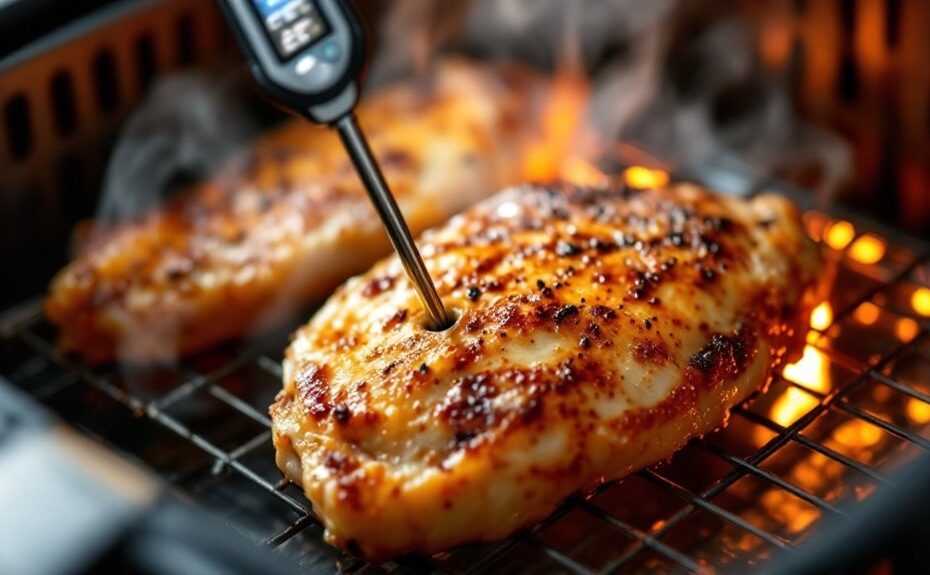You want precision, you want safety, and you want perfectly cooked meals—so can a meat thermometer help you achieve that in an air fryer? While it's tempting to rely on guesswork, using a thermometer guarantees your food reaches the right internal temperature without overcooking. But not all thermometers are created equal, and air fryers present unique challenges. What type should you use, and how do you avoid common pitfalls? The answers might just change the way you approach air frying, but there's more to think about before you start.
Key Takeaways
- Yes, you can use a meat thermometer in an air fryer, but ensure it is heat-resistant and compatible with high temperatures (up to 572°F/300°C).
- Digital thermometers are ideal for air fryers due to their quick, accurate readings and ability to withstand rapid heat circulation.
- Avoid letting the probe touch the air fryer basket or heating elements to prevent inaccurate readings or damage.
- Insert the thermometer into the thickest part of the meat, avoiding bones or fat, for the most accurate temperature measurement.
- Always calibrate your thermometer before use and follow manufacturer guidelines to ensure safety and optimal performance in the air fryer.
How a Meat Thermometer Works
A meat thermometer measures the internal temperature of food to guarantee it's cooked safely and accurately. You'll rely on its precision to confirm your food reaches the minimum safe temperatures recommended by food safety guidelines. Temperature calibration is critical; you must verify the thermometer's accuracy regularly, often using ice water or boiling water tests. Proper probe placement is equally important—insert the probe into the thickest part of the meat, avoiding bones or fat, to get an accurate reading. The thermometer's sensor detects heat and converts it into a temperature reading, which you'll use to determine doneness. Always follow manufacturer instructions for use and maintenance to maintain consistent performance. By mastering these techniques, you'll achieve reliable results every time.
Types of Meat Thermometers for Air Fryers
When using a meat thermometer in an air fryer, it's important to select one designed to withstand the appliance's high heat and rapid air circulation. Digital thermometers are a popular choice due to their quick, accurate readings and ability to handle high temperatures. Look for models with heat-resistant probes and a wide temperature range, typically up to 572°F (300°C). Analog thermometers, while less precise, can also be used if they're oven-safe and rated for air fryer conditions. Make sure the thermometer's probe is thin enough to insert without damaging the air fryer basket or food. Always verify the thermometer's compatibility with your specific air fryer model to avoid malfunctions or safety risks. Choose a thermometer that meets regulatory standards for food safety and heat resistance.
Safety Tips for Using Thermometers in Air Fryers
While using a meat thermometer in an air fryer can guarantee food safety, it's crucial to follow specific safety guidelines to prevent accidents or damage. Always confirm your thermometer is calibrated before use to maintain accuracy. Use a calibration tool or ice water method to verify its readings. When inserting the probe, follow probe placement tips to avoid contact with the air fryer basket or heating elements, which can damage the thermometer or cause inaccurate readings. Confirm the probe is securely positioned in the thickest part of the meat without touching bones or fat. Never leave the thermometer unattended during cooking, as prolonged exposure to high heat may compromise its integrity. Always handle the probe with care to avoid burns or damage to the air fryer's interior.
Best Practices for Accurate Temperature Readings
To guarantee accurate temperature readings in your air fryer, you'll need to position the thermometer probe correctly and monitor it consistently. Make certain the probe tip is inserted into the thickest part of the meat, avoiding bones or fat, as these can skew results. Use calibration techniques to verify your thermometer's accuracy before each use, especially if it's exposed to extreme temperatures. For temperature placement, avoid direct contact with the air fryer basket or heating elements, as this can cause false readings. Maintain consistent airflow by not overcrowding the basket, which secures even cooking and reliable measurements. Always follow the manufacturer's guidelines for both the air fryer and thermometer to confirm compliance with safety and performance standards. Regular checks and proper placement are critical for precision.
Common Mistakes to Avoid
Although using a meat thermometer in an air fryer can improve cooking accuracy, common mistakes often lead to unreliable results. Failing to perform thermometer calibration before use is a critical error, as uncalibrated devices can provide inaccurate readings. Always verify calibration using ice water or boiling water tests. Another frequent mistake is improper temperature placement. Insert the probe into the thickest part of the meat, avoiding bones or fat, to guarantee an accurate internal temperature reading. Additionally, avoid leaving the thermometer in the air fryer during preheating, as extreme heat can damage the device or skew results. Finally, confirm the thermometer's probe doesn't touch the air fryer basket or tray, as this can cause false readings. Addressing these errors guarantees precise and safe cooking outcomes.
Benefits of Using a Meat Thermometer in Air Fryers
Using a meat thermometer in your air fryer guarantees perfect doneness by providing accurate internal temperature readings. It prevents overcooking risks, which can compromise texture and flavor. This precision helps you achieve consistent, safe results every time.
Ensures Perfect Doneness
When cooking in an air fryer, a meat thermometer guarantees your food reaches the precise internal temperature needed for safe consumption and ideal texture. Proper temperature calibration confirms the thermometer's accuracy, aligning it with USDA-recommended safe minimums for proteins like poultry (165°F), pork (145°F), and beef (145°F for medium-rare). Correct probe placement is critical; insert the thermometer into the thickest part of the meat, avoiding bones or fat, to obtain an accurate reading. This eliminates guesswork, verifying your dish is neither undercooked nor overdone. By relying on a meat thermometer, you achieve consistent results, adhering to food safety standards while preserving the desired texture and juiciness of your meal. Precision in temperature monitoring is key to mastering air fryer cooking.
Prevents Overcooking Risks
Since air fryers cook food faster than traditional methods, a meat thermometer helps you avoid overcooking by providing real-time internal temperature readings. Overcooking not only compromises texture and flavor but also raises food safety concerns, as excessive heat can degrade nutrients and create harmful compounds. By monitoring the internal temperature, you guarantee cooking precision, stopping the process once the meat reaches the recommended safe temperature. This prevents the risk of drying out proteins or burning delicate items, which is common in air fryers due to their intense heat circulation. A meat thermometer acts as a regulatory tool, aligning your cooking with USDA guidelines for food safety. It eliminates guesswork, guaranteeing your meals are perfectly cooked without exceeding ideal internal temperatures.
Disclosure: As an Amazon Associate, I earn from qualifying purchases.



